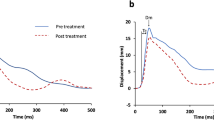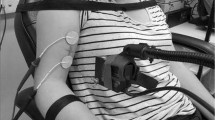Summary
Voluntary and electrically evoked contractile properties were studied in the triceps brachii following a 24-week dynamic stength training program in ten men aged 65–78 years. Eight men of a similar age were control subjects. A resistance overload program was undertaken three times per week with subjects performing four sets of six to eight repetitions at 80% of their one repetition maximum (1RM). Maximum voluntary contraction (MVC) and contractile properties were measured at 0, 12, and 24 weeks in the exercise group and at 0 and 24 weeks in the controls. The 1RM was used to assess dynamic strength at 0 and 24 weeks in the exercise group. Contractile measures consisted of supramaximal isometric twitch and post-activation twitch parameters. Muscle size was estimated from anthropometric measurements. Compared with the control group, the exercise group MVC increased by about 20% and time to peak tension was slowed by about 11%. Also in the exercise group the peak rate of torque development of the potentiated twitch was reduced by about 10%. Twitch potentiation was substantial in both groups (about 140%) and unaffected by training. The 1 RM increased by about 30%, and there was a non-singificant positive change of 8.6% in the muscle plus bone cross-sectional area in the exercise group. The results show that the force generating capacity of the triceps brachii in these men can be significantly improved for up to 24 weeks using concentric overload training. Furthermore, the finding of slowed twitch properties and no change in peak twitch amplitude substantiate and extend the limited data currently available on intrinsic contractile changes in the elderly. Mechanisms responsible for slowed twitch properties and their functional significance following strength training in aged men remain uncertain.
Similar content being viewed by others
References
Alway SE, MacDougall JD, Sale DG, Sutton JR, McComas AJ (1988) Functional and structural adaptations in skeletal muscle of trained athletes. J Appl Physiol 64: 1114–1120
Alway SE, MacDougall JD, Sale DG (1989) Contractile adaptations in human triceps surae after isometric exercise. J Appl Physiol 66: 2725–2732
Aniansson A, Grimby G, Rundgren A, Svanborg A, Orlander J (1980) Phsical training in old men. Age Ageing 9: 186–187
Belanger AY, McComas AT (1985) A comparison of contractile properties in human arm and leg muscles. Eur J Appl Physiol 54: 326–330
Beyer RE (1983) Regulation of connective tissue metabolism in aging and exercise: a review. In: Borer KT, Edington DW, White TP (eds) Frontiers of exercise biology. (Big ten body of knowledge symposium series, vol. 13) Human Kinetics, Champaign, Ill., pp 85–99
Bigland-Ritchie B, Johnson R, Lippold OCT, Smith S, Words JJ (1983) Changes in motoneurone firing rates during sustained maximal voluntary contractions. J Physiol (Lond) 340: 335–346
Brown AB, McCartney N, Sale DG (1990) Positive adaptations to weight-lifting training in the elderly. J Appl Physiol 69: 1725–1733
Chapman EA, DeVries HA, Swezey R (1973) Joint stiffness: effects of exercise programs in persons over sixty. Phys Ther Rev 41: 633–635
Davies CTM, Young A (1982) Effects of training at 30 and 100% maximal isometric force (MVC) on the contractile properties of the triceps surae in man. J Physiol (Lond) 336: 22–23P
Davies CTM, Dooley P, McDonagh MJN, White MJ (1985) Adaptation of mechanical properties of muscle to high force training in man. J Physiol (Lond) 365: 277–284
deKoning FL, Binkhorst RA, Kauer JMG, Thijssen HOM (1986) Accuracy of an anthropometric estimate of the muscle and bone area in a transversal cross-section of the arm. Int J Sports Med 7: 246–249
Duchateau J, Hainaut K (1984) Isometric or dynamic training: differential effects on mechanical properties of a human muscle. J Appl Physiol Respir Environ Exerc Physiol 56: 296–301
Fiatarone MA, Marks EC, Ryan ND, Meredith CN, Lipsitz LA, Evans WJ (1990) High-intensity strength training in nonagenarians. JAMA 263: 3029–3034
Frontera WR, Meredith CN, O'Reilly KP, Knuttgen HG, Evans WJ (1988) Strength conditioning in older men: skeletal muscle hypertrophy and improved function. J Appl Physiol 64: 1038–1044
Grimby G (1987) Physical activity and muscle training in the elderly. Acta Med Scand [Suppl] 711: 233–237
Hill AV (1951) The effect of series compliance on tension development in a muscle twitch. Proc Soc Lond [Biol] 138: 325–329
Kaufman TL (1985) Strength training effect in young and aged women. Arch Phys Med Rehabil 66: 223–226
Less M, Krewer SE, Eickelberg WW (1977) Exercise effect on strength and range of motion of hand-intrinsic muscles and joints. Arch Phys Med Rehabil 58: 370–374
McDonagh MJN, Hayward CM, Davies CTM (1983) Isometric training in human elbow flexor muscles: the effects on voluntary and electrically evoked forces. J Bone Joint Surg 65: 355–358
Moritani T, deVries HA (1980) Potential for gross muscle hypertrophy in older men. Gerontol 35: 672–682
Pousson M, Van Hoecke J, Goubel F (1990) Changes in elastic characteristics of human muscle induced by eccentric exercise. J Biomech 23: 343–348
Rice CL, Cunningham DA, Paterson DH, Lefcoe MS (1990) A comparison of anthropometry with computed tomography in limbs of young and aged men. J Gerontol 5: M175–179
Rutherford OM, Jones DA (1986) The role of learning and coordination in strength training. Eur J Appl Physiol 55: 100–105
Sale DG (1986) Neural adaptation in strength and power training. In: Jones NL, McCartney N, McComas AJ (eds) Human muscle power. Human Kinetics, Champaign, Ill., pp 289–304
Sale DG, McComas AJ, MacDougall JD, Upton ARM (1982) Neuromuscular adaptation in human thenar muscles following strength training and immobilization. J Appl Physiol Respir Environ Exerc Physiol 53: 419–424
Vailas AC, Pedrini VA, Pedrini-Mille A, Holloszy J (1985) Patellar tendon matrix changes associated with aging and voluntary exercise. J Appl Physiol 58: 1572–1576
Vandervoort AA, Heyes KC, Belanger AY (1986) Strength and endurance of skeletal muscle in the elderly. Physiother Can 38: 167–173
Viidik A (1982) Age-related changes in connective tissues. In: Viidik A (ed) Lectures on gerontology, vol. l. On biology of ageing, part A. Academic Press, New York, pp 173–211
Author information
Authors and Affiliations
Rights and permissions
About this article
Cite this article
Rice, C.L., Cunningham, D.A., Paterson, D.H. et al. Strength training alters contractile properties of the triceps brachii in men aged 65–78 years. Europ. J. Appl. Physiol. 66, 275–280 (1993). https://doi.org/10.1007/BF00235106
Accepted:
Issue Date:
DOI: https://doi.org/10.1007/BF00235106




